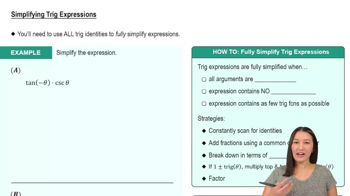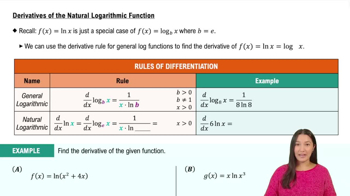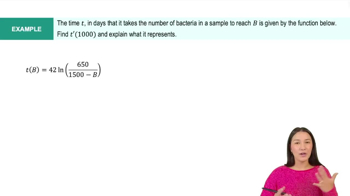Table of contents
- 0. Functions7h 52m
- Introduction to Functions16m
- Piecewise Functions10m
- Properties of Functions9m
- Common Functions1h 8m
- Transformations5m
- Combining Functions27m
- Exponent rules32m
- Exponential Functions28m
- Logarithmic Functions24m
- Properties of Logarithms34m
- Exponential & Logarithmic Equations35m
- Introduction to Trigonometric Functions38m
- Graphs of Trigonometric Functions44m
- Trigonometric Identities47m
- Inverse Trigonometric Functions48m
- 1. Limits and Continuity2h 2m
- 2. Intro to Derivatives1h 33m
- 3. Techniques of Differentiation3h 18m
- 4. Applications of Derivatives2h 38m
- 5. Graphical Applications of Derivatives6h 2m
- 6. Derivatives of Inverse, Exponential, & Logarithmic Functions2h 37m
- 7. Antiderivatives & Indefinite Integrals1h 26m
- 8. Definite Integrals4h 44m
- 9. Graphical Applications of Integrals2h 27m
- 10. Physics Applications of Integrals 2h 22m
6. Derivatives of Inverse, Exponential, & Logarithmic Functions
Derivatives of Exponential & Logarithmic Functions
Problem 3.9.8
Textbook Question
Find d/dx(ln(x/x²+1)) without using the Quotient Rule.
 Verified step by step guidance
Verified step by step guidance1
First, recognize that the function inside the logarithm is a composition of functions: ln(u), where u = x/(x² + 1).
Apply the chain rule for differentiation: d/dx[ln(u)] = (1/u) * du/dx.
To find du/dx, express u = x/(x² + 1) as a product: u = x * (x² + 1)^(-1).
Use the product rule to differentiate u: d/dx[x * (x² + 1)^(-1)] = (d/dx[x]) * (x² + 1)^(-1) + x * d/dx[(x² + 1)^(-1)].
Differentiate (x² + 1)^(-1) using the chain rule: d/dx[(x² + 1)^(-1)] = -1 * (x² + 1)^(-2) * d/dx[x² + 1].
 Verified video answer for a similar problem:
Verified video answer for a similar problem:This video solution was recommended by our tutors as helpful for the problem above
Video duration:
4mPlay a video:
Was this helpful?
Key Concepts
Here are the essential concepts you must grasp in order to answer the question correctly.
Natural Logarithm Properties
The natural logarithm, denoted as ln, has specific properties that simplify expressions. One key property is that ln(a/b) = ln(a) - ln(b). This property allows us to break down complex logarithmic expressions into simpler components, making differentiation easier without applying the Quotient Rule.
Recommended video:

Change of Base Property
Chain Rule
The Chain Rule is a fundamental differentiation technique used when dealing with composite functions. It states that if a function y = f(g(x)), then the derivative dy/dx = f'(g(x)) * g'(x). This rule is essential for differentiating functions where one function is nested within another, which is often the case in logarithmic expressions.
Recommended video:

Intro to the Chain Rule
Simplifying Expressions Before Differentiation
Before differentiating, simplifying expressions can significantly ease the process. This involves rewriting complex functions in a more manageable form, such as factoring or using logarithmic identities. By simplifying ln(x/(x²+1)) to ln(x) - ln(x²+1), we can apply the properties of logarithms to differentiate each term separately, avoiding the need for the Quotient Rule.
Recommended video:

Simplifying Trig Expressions

 4:50m
4:50mWatch next
Master Derivatives of General Exponential Functions with a bite sized video explanation from Callie
Start learningRelated Videos
Related Practice














